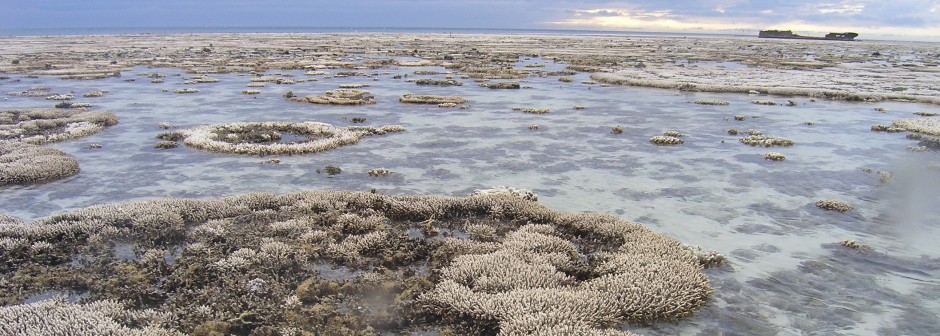When I think of coral reefs, I think of towers of tangled coral branches, exploding with movement, color, and life. I think of Mr. Ray from Finding Nemo guiding a school of young fish through a maze of corals and algae. That’s why it just feels… wrong… to see bleached reefs. Bleached corals don’t look like anything from the movies – they look like sickly, white masses of tissue and bone.
To put it in terms of human emotions, bleached corals look sad. And that’s because they’re missing their soulmates… their life partners… their symbiotic micro-algae.

Bleached coral colonies looking sad. Photo (by Edwin A. Hernandez-Delgado) from the cover of Ecosphere.
These micro-algae, belonging to the genus Symbiodinium, are unicellular protists that live inside of healthy corals. When times are good, the corals provide shelter and other compounds to the algae. In return, the algae produce oxygen, remove waste, and create energy for their hosts [1]. They also contain pigments that give corals their signature bright colors. Like any relationship, the symbiosis between coral and alga is a delicate balance of give and take. They both need each other to survive, but under stress, the relationship can fall apart.
When reef ecosystems are exposed to stressors like increased temperatures, pollution, overexposure to sunlight, and/or low tides, corals expel their Symbiodinium and become bleached [2]. Bleaching can be widespread and disastrous for reefs. In 2005, extremely high temperatures in the Caribbean, around 1.2 ºC higher than average, caused over 80% of corals in the area to bleach. That year, over 40% of the surveyed Caribbean corals died from bleaching [3].
![High temperatures that caused coral bleaching in the Caribbean during the 2005 bleaching event. Figure from Eakin et al, 2010 [4].](https://coralreefs.blogs.rice.edu/files/2016/02/journal.pone_.0013969.g001-1fran0w-300x119.png)
High temperatures that caused coral bleaching in the Caribbean during the 2005 bleaching event. Figure from Eakin et al, 2010 [4].
But the story isn’t over yet!
As we enter a year that the National Oceanic and Atmospheric Administration (NOAA) has declared to be the “third ever global coral bleaching event,” the suspense thickens [2]. After surviving the first two global bleaching events in 1998 and 2010 as well record high temperatures in 2005, Caribbean reefs are damaged, yet alive [3].
Throughout the next couple of months, I’ll be following scientific research on the warming reefs of the Caribbean. What will happen to our Caribbean friends? Are they too damaged to recover, or has the previous history of bleaching made them stronger? Is there still something we can still do, or is this the last straw?
Only time will tell!
References
[1] “Symbiotic Algae.” NOAA Coral Reef Conservation Program. National Oceanic and Atmospheric Administration, 13 May 2011. Web. 17 February 2016.
[2] “NOAA Declares Third Ever Global Coral Bleaching Event.” NOAA. National Oceanic and Atmospheric Administration, 8 Oct. 2015. Web. 17 February 2016.
[3] “Heat Stress to Caribbean Corals in 2005 Worst in Record.” NOAA. National Oceanic and Atmospheric Administration, 15 Nov. 2010. Web. 17 February 2016.
[4] Eakin, Mark et al. “Caribbean Corals in Crisis: Record Thermal Stress, Bleaching, and Mortality in 2005.” PLoS One 15.5 (2010):e13969. Web. 18 February 2010.

